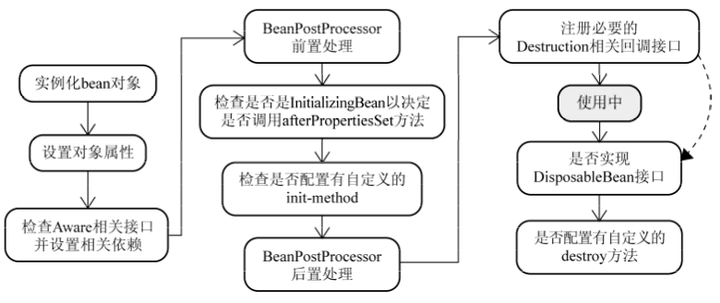1.作用域
①singleton spring中的单例是基于BeanFactory的,在容器中只有一个
不管是否使用,容器里面都是同一个对象
<bean id="ServiceImpl" class="cn.csdn.service.ServiceImpl" scope="singleton">②prototype 从此从容器中获取bean,会返回一个新的实例
一个bean对应多个实例,创建容器的时候并没有实例化,当获取的时候才去创建,并且每次获取的都不一样。
所以无状态的bean使用单例,有状态的使用原型。
<bean id="test" class="com.foo.Default" scope="prototype"/>or
<bean id="test" class="com.foo.Default" singleton="false"/> ③request 每次http请求都会创建新的bean,仅适用于WebApplicationContext
一个bean对应一个实例,但是每个请求都有各自的bean实例
<bean id="loginAction" class=cn.csdn.LoginAction" scope="request"/>并且每次http请求创建的loginAction bean只在当前请求内有效,并且相互之间隔离,一旦请求结束就销毁了。
④session 相同http session共享一个bean,不同的session则是不同bean,仅适用于WebApplicationContext
同request,一个bean只有一个实例
<bean id="userPreferences" class="com.foo.UserPreferences" scope="session"/>同request,创建的是userPreferences bean
⑤global session portlet应用,仅适用于WebApplicationContext
同request,一个bean只有一个实例
<bean id="user" class="com.foo.Preferences "scope="globalSession"/>仅仅在portlet应用中才有意义,它被所有构成某个portlet web应用的各种不同的portlet共享。
2.生命周期
图片来源https://www.zhihu.com/question/38597960?sort=created

①.实例化;
②.填充属性;
③.BeanNameAware,将Bean的ID传递给setBeanName()方法;
④.BeanFactoryAware,将调用setBeanDactory()方法并把BeanFactory容器实例作为参数传入;
⑤.ApplicationContextAware,调用setApplicationContext()方法,把应用上下文作为参数传入;
⑥.BeanPostProcess,调用postProcessBeforeInitialization方法(对bean进行修改等操作);
⑦.InitializingBean,调用afterPropertiesSet方法,初始化bean;
⑧.BeanPostProcess,调用postProcessAfterInitialization方法(对bean进行修改等操作);
⑨.bean将存活至上下文被销毁
⑩.DispostbleBean,调用destory方法,在Bean实例销毁前执行。
⑪.销毁完成